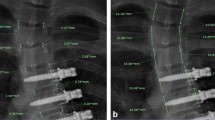Abstract
Study design
Retrospective case series.
Objective
To quantitatively measure the rate of growth of vertebral bodies in juvenile idiopathic scoliosis (JIS) treated with vertebral body stapling (VBS).
Summary of background data
VBS has been suggested to be a safe and effective method for modulating the growth of the young scoliotic spine, but few long-term studies have examined its efficacy.
Methods
Seven patients with JIS 11 years of age or younger underwent VBS with a minimum 6-year follow-up. Vertebral body height on the unstapled and stapled aspects of the curve was measured from initial and final postoperative radiographs and converted into rate of growth per year. Known staple dimensions were used to standardize the measurements between radiographs. Interstaple distance was measured to demonstrate continued growth of the spine. Adjacent vertebral bodies without instrumentation served as an internal control of growth. Each vertebral body (n = 35) was analyzed as an individual experimental unit.
Results
The average rate of growth was 0.86 mm/year (standard deviation [SD] 0.44, 95% confidence interval [CI] 0.71–1.0) per vertebral body on the stapled side and 0.83 mm/year (SD 0.46, 95% CI 0.67–0.98) per vertebral body on the unstapled side of the vertebral body. The adjacent vertebral body segments grew at a rate of 0.91 mm/year (SD 0.42, 95% CI 0.66–1.15) on the stapled side and 0.99 mm/year (SD 0.66, 95% CI 0.61–1.37) on the unstapled side, p < 0.01. The distance between staples increased significantly from 3.0 mm (SD 2.0, 95% CI 2.3–3.6) to 8.4 mm (SD 2.4, 95% CI 7.7–9.3).
Conclusions
Vertebral body growth in the presence of VBS occurred at a similar rate on the stapled and unstapled sides of the curve. The high standard deviation of instrumented segment growth further supports the conclusion that VBS is not a reliable method of growth modulation in the young scoliotic spine.
Level of evidence
IV.



Similar content being viewed by others
References
Betz RR, Kim J, D’Andrea LP et al (2003) An innovative technique of vertebral body stapling for the treatment of patients with adolescent idiopathic scoliosis: a feasibility, safety, and utility study. Spine 28:S255
Betz RR, D’Andrea LP, Mulcahey MJ, Chafetz RS (2005) Vertebral body stapling procedure for the treatment of scoliosis in the growing child. Clin Orthop Relat Res 434:55–60
Smith A, von Lackum H, Wylie R (1954) An operation for stapling vertebral bodies in congenital scoliosis. J Bone Jt Surg Am 36:342
Shillington MP, Labrom RD, Askin GN, Adam CJ (2011) A biomechanical investigation of vertebral staples for fusionless scoliosis correction. Clin Biomech 26:445–451
Aronsson DD, Stokes IA, McBride C (2010) The role of remodeling and asymmetric growth in vertebral wedging. Stud Health Technol Inform 158:11
Driscoll M, Aubin C, Moreau A, Parent S (2011) Biomechanical comparison of fusionless growth modulation corrective techniques in pediatric scoliosis. Med Biol Eng Comput 49:1437–1445
Stokes IA (2007) Analysis and simulation of progressive adolescent scoliosis by biomechanical growth modulation. Eur Spine J 16:1621–1628
Laituri CA, Schwend RM 3rd (2012) Thoracoscopic vertebral body stapling for treatment of scoliosis in young children. J Laparoendosc Adv Surg Tech A. 22:830–833
Betz RR, Ranade A, Samdani AF et al (2010) Vertebral body stapling: a fusionless treatment option for a growing child with moderate idiopathic scoliosis. Spine 35:169–176
Bumpass DB, Fuhrhop SK, Schootman M et al (2015) Vertebral body stapling for moderate juvenile and early adolescent idiopathic scoliosis: cautions and patient selection criteria. Spine 40:E1305–E1314
Clayson D, Luz-Alterman S, Cataletto MM, Levine DB (1987) Long-term psychological sequelae of surgically versus nonsurgically treated scoliosis. Spine 12:983–986
Misterska E, Glowacki M, Harasymczuk J (2011) Brace and deformity-related stress level in females with adolescent idiopathic scoliosis based on the bad sobernheim stress questionnaires. Med Sci Monit 17:CR83–CR90
Misterska E, Glowacki M, Latuszewska J (2012) Female patients’ and parents’ assessment of deformity- and brace-related stress in the conservative treatment of adolescent idiopathic scoliosis. Spine 37:1218–1223
Weinstein SL, Dolan LA, Wright JG, Dobbs MB (2013) Effects of bracing in adolescents with idiopathic scoliosis. N Engl J Med 369:1512
Braun JT, Ogilvie JW, Akyuz E et al (2004) Fusionless scoliosis correction using a shape memory alloy staple in the anterior thoracic spine of the immature goat. Spine 29:1980–1989
Carreau JH, Farnsworth CL, Glaser DA et al (2012) The modulation of spinal growth with nitinol intervertebral stapling in an established swine model. J Child Orthop 6:241–253
Wall EJ, Bylski-Austrow DI, Kolata RJ, Crawford AH (2005) Endoscopic mechanical spinal hemiepiphysiodesis modifies spine growth. Spine 30:1148–1153
Braun JT, Hines JL, Akyuz E et al (2006) Relative versus absolute modulation of growth in the fusionless treatment of experimental scoliosis. Spine 31:1776–1782
Theologis AA, Cahill P, Auriemma M et al (2013) Vertebral body stapling in children younger than 10 years with idiopathic scoliosis with curve magnitude of 30° to 39. Spine 38:E1583–E1588
Weinstein SL, Zavala DC, Ponseti IV (1981) Idiopathic scoliosis: long-term follow-up and prognosis in untreated patients. J Bone Jt Surg Am 63:702–712
Funding
None.
Author information
Authors and Affiliations
Corresponding author
Ethics declarations
Conflict of interest
EM, RT, AS, and RMS have no conflicts of interest.
Ethical approval
Reviewed and approved by the Pediatric IRB at The Children’s Mercy Hospital & Clinics (IRB # 15080376).
Additional information
Publisher’s Note
Springer Nature remains neutral with regard to jurisdictional claims in published maps and institutional affiliations.
Rights and permissions
About this article
Cite this article
Murray, E., Tung, R., Sherman, A. et al. Continued vertebral body growth in patients with juvenile idiopathic scoliosis following vertebral body stapling. Spine Deform 8, 221–226 (2020). https://doi.org/10.1007/s43390-019-00019-x
Received:
Accepted:
Published:
Issue Date:
DOI: https://doi.org/10.1007/s43390-019-00019-x




